Smooth, precise cuts make all the difference, and a band saw delivers exactly that. Whether cutting curves, resawing thick lumber, or crafting intricate details, this versatile tool is a game-changer for woodworkers and metalworkers alike. Unlike circular saws, band saws use a continuous blade that glides effortlessly through material, reducing waste and ensuring cleaner cuts with minimal effort.
Available in both benchtop and floor-standing models, band saws offer adjustable cutting speeds, blade guides, and powerful motors to handle a variety of tasks. From professional workshops to home garages, they excel in shaping, trimming, and slicing through wood, metal, and even plastic with precision.
A well-chosen band saw expands your creative possibilities, making detailed craftsmanship easier than ever. Find the perfect model to enhance your workflow and take your projects to the next level.
Our Top Band Saw Picks
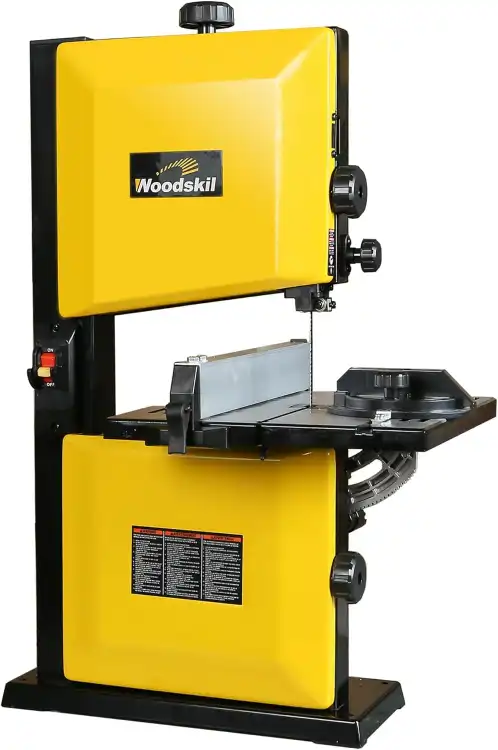
Woodskil 3-Amp 9-Inch Band Saw
Check on AmazonKey Specs
- Cutting Capacity: Supports a maximum depth of 3-1/2 inches and a width of 9 inches
- Adjustable Tilting Table: 0° to 45° tilt range with a 120° miter gauge for precise angle cuts
- Enhanced Stability: Heavy-duty steel base minimizes vibrations for a steady cutting experience
- Precision Cutting: Includes a rip fence for straight, accurate cuts
- Dust Management: 2-1/2-inch dust port and built-in dust brush help maintain a clean workspace
The WoodSkil 3-Amp 9-Inch Band Saw is a powerful and efficient cutting tool designed for woodworking and soft metal applications. With a 2500 FPM blade speed and a 1720 RPM motor, it ensures smooth and precise cuts without power loss. The 59-1/2-inch carbon steel blade accommodates widths from 1/8 to 3/8 inches, allowing for straight, curved, and angled cuts.
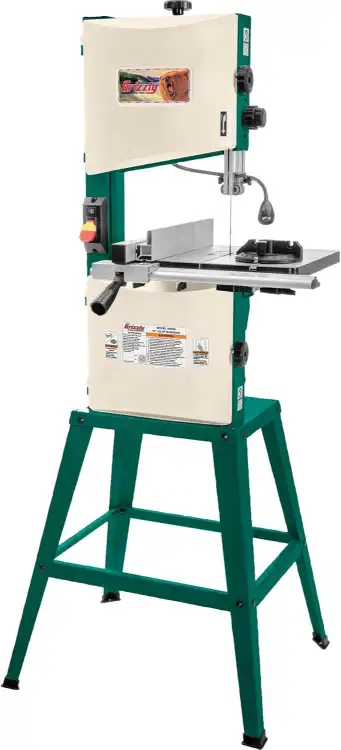
Grizzly Industrial G0948 BandSaw
Check on AmazonKey Specs:
- Precision Cutting: Extruded aluminum fence for precise ripping and resawing
- ✔ Dust Management: Combination 2″, 3″, and 4″ dust ports for efficient dust collection
- ✔ Stable Performance: Steel stand with vibration-resistant rubber feet for added stability
- ✔ Adjustable Table: Tilts 0–45° for angled cuts and miters
- ✔ Enhanced Visibility: Flexible LED work light illuminates the work area
- ✔ Clean Operation: Wheel brush keeps the bottom tire clean for smooth performance
- ✔ Durable Transmission: Ribbed Poly-V belt for efficient power transfer
The Grizzly Industrial G0948 Band Saw is a powerful and precise cutting tool, designed for woodworking and light metal applications. With its two-speed cutting options, fully adjustable ball-bearing blade guides, and tilting table (0–45°), this bandsaw ensures versatile and accurate cuts for various projects.
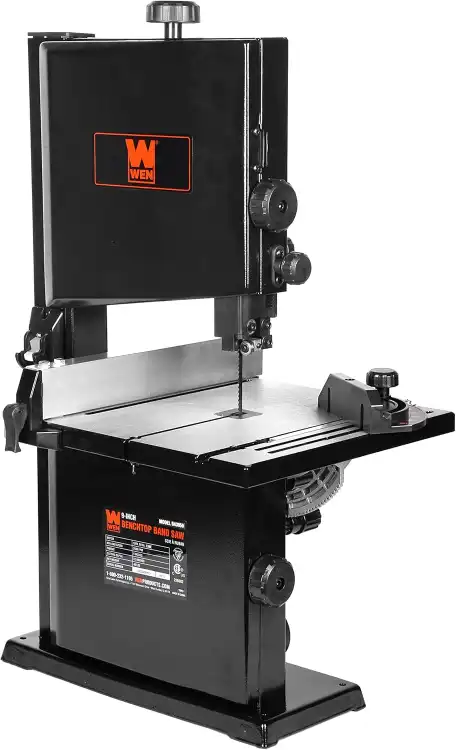
WEN 9-Inch Band Saw
Check on Amazon
Key Specs:
- Powerful Cutting Performance: 2.8-amp motor for smooth and consistent cuts
- ✔ Versatile Cutting Capacity: Handles cuts up to 3-1/2 inches deep and 9 inches wide
- ✔ Adjustable Table: Tilts up to 45° for beveled cuts
- ✔ Blade Compatibility: Accepts 1/8 to 3/8-inch wide blades for various cutting applications
- ✔ Complete Setup: Includes 1/4-inch-wide blade, rip fence, miter gauge, and adjustable blade guard
- ✔ Dust Management: 2-1/2-inch dust port keeps the workspace clean
- ✔ Warranty: 2-year manufacturer warranty for peace of mind
The WEN 9-Inch Band Saw delivers precision cutting and reliable performance for woodworking projects. Equipped with a 2.8-amp motor, this saw powers the 59-1/2-inch blade at speeds of up to 2500 feet per minute, allowing for smooth and efficient cutting.
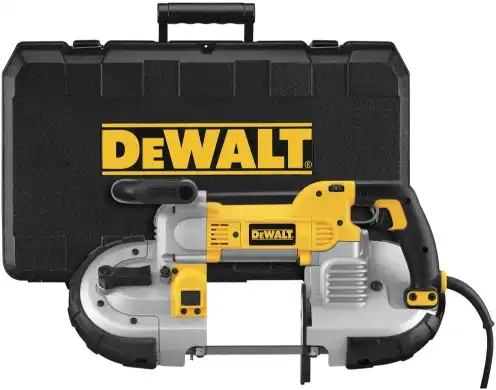
DEWALT Portable Band Saw
Check on AmazonKey Specs:
- 10-amp motor for powerful cutting performance
- 5-inch deep cut capacity for round and rectangular stock
- Steel shroud and rubber bumpers for durability
- LED sight light for improved visibility in low-light areas
- Integrated hang hook for easy storage
- Variable speed dial (100-350 SPM) for material-specific adjustments
- Large front handle for better control and comfort
- Blade tracking adjustment for extended blade life
The DEWALT Portable Band Saw is a powerful, durable, and precise tool designed for professional-grade cutting applications. Equipped with a 10-amp motor, this saw is built to handle heavy-duty jobsite tasks with ease.
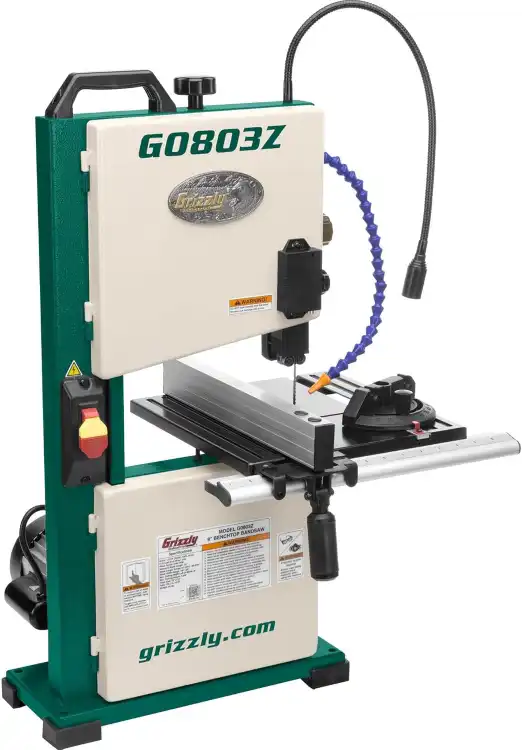
Grizzly Industrial 9″ Benchtop Bandsaw
Check on AmazonKey Specs:
- Blade Material: Carbon Steel
- Power Source: Corded Electric
- Surface Compatibility: Metal
- Special Feature: Dust Collection
- Table Tilt: Rack-and-pinion adjustment
The Grizzly Industrial 9″ Benchtop Bandsaw is engineered for precision and efficiency. I appreciate its adjustable wheels, ensuring perfect blade alignment for smooth, accurate cuts. The rack-and-pinion table tilt allows seamless angle adjustments, while the ball-bearing blade guides enhance stability during operation. The oversized bevel scale with positive stops simplifies angled cuts, making it ideal for detailed work. Its quick-release blade tension levers enable fast blade changes, improving workflow efficiency.
Mastering Band Saw Techniques: A Woodworker’s Guide
As a woodworking enthusiast, you must be familiar with the band saw, a versatile tool that can make intricate cuts and shapes in various materials. The band saw consists of a continuous band of toothed metal stretched between two or more wheels, allowing for precision cutting. Mastering band saw techniques is crucial for any woodworker looking to elevate their craft and create stunning projects with ease.
Safety Precautions
When using a band saw, safety should always be a top priority. Proper attire, including safety goggles, ear protection, and non-slip footwear, is essential to prevent accidents. Blade tension and tracking must be adjusted correctly to avoid blade slippage or breakage during operation. Additionally, blade guards and guides should always be in place to protect your hands and fingers from the sharp blade.
Safety Precautions Table:
| Safety Precautions |
|———————|
| Proper attire and safety gear |
| Blade tension and tracking |
| Blade guards and guides |
Blade Selection and Maintenance
Choosing the right blade for the job is crucial for achieving clean and accurate cuts. Different blades are designed for specific tasks, such as resawing, ripping, or curved cutting. Proper blade tensioning and tracking adjustments ensure that the blade stays in place during operation. Regular blade maintenance, including cleaning and sharpening, prolongs the life of the blade and ensures consistent cutting performance.
Blade Selection and Maintenance List:
– Choose the appropriate blade for the task at hand
– Check and adjust blade tension and tracking before each use
– Regularly clean and sharpen the blade for optimal performance
Resawing Techniques
Resawing is the process of cutting a board into thinner pieces along its width, allowing you to create bookmatched panels or veneers. Setting up the band saw for resawing involves adjusting the blade guides and fence to ensure a straight cut. Tips for achieving straight and even cuts include using a feather board to apply consistent pressure and feeding the material through the saw at a steady pace.
Resawing Techniques Table:
| Resawing Techniques |
|———————|
| Definition and importance of resawing |
| Setting up the band saw for resawing |
| Tips for achieving straight and even cuts |
Curved Cutting Techniques
Understanding blade drift, the tendency of the blade to veer off course during curved cuts, is essential for mastering curved cutting techniques. Using a fence to guide the material during curved cuts helps maintain accuracy and control. Practice exercises, such as cutting intricate patterns or curves on scrap wood, can help improve your skills and confidence in making curved cuts with precision.
Curved Cutting Techniques List:
– Learn to identify and compensate for blade drift
– Use a fence to guide the material during curved cuts
– Practice cutting various curved shapes to improve your technique
Ripping Techniques
Ripping on a band saw involves cutting a board along its length to create narrower strips. Setting up the band saw for ripping requires adjusting the blade height and using a rip fence for straight cuts. Using a rip fence helps maintain a consistent width throughout the cut, while avoiding common mistakes like forcing the material through the saw or using a dull blade ensures clean and accurate results.
Ripping Techniques Table:
| Ripping Techniques |
|———————|
| Setting up the band saw for ripping |
| Using a rip fence for straight cuts |
| Common mistakes to avoid when ripping |
Crosscutting Techniques
Crosscutting on a band saw involves cutting a board across its width to achieve shorter pieces. Setting up the band saw for crosscutting includes adjusting the miter gauge for accurate angle cuts and using a stop block for consistent lengths. Using a miter gauge helps guide the material at the desired angle, while following safety tips such as keeping your hands away from the blade ensures a safe and precise cutting process.
Crosscutting Techniques List:
– Adjust the miter gauge for accurate crosscuts
– Use a stop block for consistent lengths
– Follow safety guidelines to prevent accidents during crosscutting
Resawing vs. Ripping vs. Crosscutting
Understanding the key differences between resawing, ripping, and crosscutting techniques is essential for choosing the right method for different woodworking projects. Resawing is ideal for creating thin boards or veneers, ripping is suitable for cutting boards into narrower pieces, and crosscutting is perfect for achieving shorter lengths with precision. Each technique has its advantages and limitations, making it important to select the most appropriate one based on your project requirements.
Resawing vs. Ripping vs. Crosscutting Table:
| Technique | Ideal For | Advantages | Limitations |
|———–|———–|————|————-|
| Resawing | Thin boards or veneers | Creates bookmatched panels, precise cuts | Requires a powerful band saw |
| Ripping | Narrower pieces | Efficient for cutting long boards | Limited to straight cuts |
| Crosscutting | Shorter lengths | Accurate angle cuts | Challenging for wide boards |
Advanced Band Saw Techniques
Once you have mastered the basic band saw techniques, you can explore advanced methods to enhance your woodworking skills. Compound cuts involve tilting the table and blade to create intricate shapes, while scroll cutting allows for detailed and artistic designs. Dovetail cutting on a band saw enables you to create strong and visually appealing joints for furniture and other woodworking projects.
Advanced Band Saw Techniques List:
– Experiment with compound cuts for unique shapes
– Practice scroll cutting for intricate designs
– Master dovetail cutting for precise joinery
Troubleshooting Common Band Saw Issues
Despite mastering band saw techniques, woodworkers may encounter common issues such as blade drift, uneven cuts, or blade breakage. Understanding how to troubleshoot these problems is essential for maintaining the performance of your band saw. Adjusting the blade tracking, checking for blade alignment, or replacing a dull blade can help resolve issues and ensure smooth cutting operations.
Troubleshooting Common Band Saw Issues Table:
| Common Issues | Troubleshooting Tips |
|—————|———————-|
| Blade drift | Adjust blade tracking and tension |
| Uneven cuts | Check for blade alignment and sharpness |
| Blade breakage | Replace with a new blade if damaged |
Practice Projects for Skill Development
To hone your band saw skills, consider undertaking practice projects that challenge your abilities and creativity. Simple beginner projects like cutting basic shapes or curves can help you familiarize yourself with the band saw. Intermediate level projects such as creating small furniture pieces or intricate patterns allow you to refine your techniques. Advanced projects like crafting complex joinery or detailed sculptures push your skills to the next level and showcase your mastery of band saw techniques.
Practice Projects for Skill Development List:
– Beginner projects: Cutting basic shapes or curves
– Intermediate projects: Creating small furniture pieces or patterns
– Advanced projects: Crafting complex joinery or detailed sculptures
Resources for Further Learning
For woodworkers looking to expand their knowledge and skills in band saw techniques, various resources are available for further learning. Books and online resources provide in-depth tutorials and guides on mastering different cutting methods and projects. Woodworking classes and workshops offer hands-on training and expert guidance to improve your proficiency with the band saw. Joining woodworking communities and forums allows you to connect with fellow enthusiasts, share experiences, and seek advice on enhancing your woodworking skills.
Resources for Further Learning Table:
| Resources | Description |
|———–|————-|
| Books and online resources | Comprehensive guides and tutorials |
| Woodworking classes and workshops | Hands-on training and expert guidance |
| Woodworking communities | Networking with fellow enthusiasts for support and advice |
Conclusion
Mastering band saw techniques is essential for any woodworker looking to elevate their craft and create intricate projects with precision and efficiency. By following safety precautions, selecting the right blade, and practicing various cutting techniques, you can enhance your woodworking skills and tackle a wide range of projects with confidence. Remember to continue practicing and exploring new methods to unlock the full potential of the band saw in your woodworking endeavors.
FAQ Section
How do I prevent blade drift when making curved cuts on a band saw?
To prevent blade drift during curved cuts, ensure that the blade tension is properly adjusted and use a fence to guide the material along the desired curve. Practice cutting on scrap wood to improve your technique and control over the blade drift.
What is the difference between resawing and ripping on a band saw?
Resawing involves cutting a board into thinner pieces along its width, while ripping involves cutting a board along its length to create narrower strips. Resawing is ideal for creating veneers or bookmatched panels, while ripping is suitable for making narrower boards.
How can I troubleshoot blade breakage issues on my band saw?
If you encounter blade breakage issues on your band saw, check for any signs of damage or wear on the blade. Replace the blade with a new one if it is dull or damaged, and ensure that the blade tension and tracking are properly adjusted to prevent breakage.
